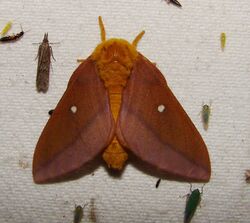Biology:Anisota virginiensis
| Anisota virginiensis | |
|---|---|

| |
| Scientific classification | |
| Domain: | Eukaryota |
| Kingdom: | Animalia |
| Phylum: | Arthropoda |
| Class: | Insecta |
| Order: | Lepidoptera |
| Family: | Saturniidae |
| Genus: | Anisota |
| Species: | A. virginiensis
|
| Binomial name | |
| Anisota virginiensis (Drury, 1773)
| |
| Synonyms | |
Anisota virginiensis, the pink-striped oakworm moth, is a species of silk moth of the family Saturniidae.
Description
The female's wings are purplish red with ochre-yellow. They have thin scales and are almost transparent. The male's wings are purplish brown with a large transparent space in the middle.[2] The female is larger than the male. The wing span is 4.2 to 6.6 centimeters.
Habitat
The moth can be found across Canada from Nova Scotia to southeastern Manitoba,[3] and in the United States. It lives in deciduous woodlands and suburbs.[4]
Biology
Females release a pheromone which attracts males that swarm around her like bees. Mating occurs during the morning.[3] It is a rapid process. The male and female stay together for the rest of the day and then the female finds a place to lay eggs, usually under oak leaves.[3] Such mating swarms have been observed at carrion, where host plants may be higher quality due to the influx of nutrients associated with decomposition.[5]
The caterpillars are gray or greenish with dull brownish yellow or rosy stripes. There are scales on each segment and two long spines on the mesothorax.[2] The caterpillars pupate for a short time.[3] They feed on the foliage of oak trees, maples, birches, and hazels. The caterpillar overwinters in the soil as a pupa. Caterpillars that are newly hatched or are in the middle of growing feed in groups while those that are mature or nearly so feed separately.[6] The caterpillar is about an eighth of an inch long. The head is large in proportion to the body. The inside of the mouth is yellow. The legs are semi-translucent.[7]
Ecology
Conservation regimes are not required for this species.[4] It is considered a pest of forests because it defoliates trees.[6] Outbreaks can be treated with an arsenical spray.[8]
Life cycle gallery
Larvae feeding on Quercus texana
References
- ↑ 1.0 1.1 Tuskes, Paul M.; P. Tuttle, James; Collins, Michael M. (1996). The wild silk moths of North America: a natural history of the Saturniidae of the United States and Canada. Cornell University Press. pp. 250. ISBN 0801431301. https://books.google.com/books?id=3vqpGATXU2oC&pg=RA1-PA74.
- ↑ 2.0 2.1 Henry Comstock, John; Botsford Comstock, Anna (1899). A manual for the study of insects. Comstock Pub. Co.. pp. 348. https://archive.org/details/bub_gb_4lMDAAAAYAAJ. "Anisota virginiensis."
- ↑ 3.0 3.1 3.2 3.3 M. Tuskes, Paul; P. Tuttle, James; M. Collins, Michael (1996). The wild silk moths of North America: a natural history of the Saturniidae of the United States and Canada. Cornell University Press. pp. 74–75. ISBN 978-0-8014-3130-2. https://books.google.com/books?id=3vqpGATXU2oC&pg=RA1-PA75.
- ↑ 4.0 4.1 "Pink-striped oakworm moth Anisota virginiensis (Drury, 1773)". Butterflies and Moths of North America. http://www.butterfliesandmoths.org/species?l=3350. Retrieved 2010-05-29.
- ↑ Mason, D.; Baruzzi, C. (2019). "Love in strange places.". Frontiers in Ecology and the Environment 17 (3): 184-184. doi:10.1002/fee.2027.
- ↑ 6.0 6.1 L. Hyche, L.. "Pinkstriped Oakworm Anisota virginiensis (Drury) (Saturniidae)". Auburn University. http://www.ag.auburn.edu/enpl/bulletins/pinkoakworm/pinkoakworm.htm. Retrieved 2010-05-29.
- ↑ Entomological Society of Ontario; Ontario. Dept. of Agriculture; Ontario. Legislative Assembly (1908). Annual report, Volumes 38-41. The Society. pp. 74. https://archive.org/details/annualreportvol00assegoog. "Anisota virginiensis."
- ↑ Massachusetts Agricultural Experiment Station (1914). Bulletin on Forestry, Volume 1, Issues 156-435. pp. 32. https://books.google.com/books?id=uE3VAAAAIAAJ&q=Anisota+virginiensis&pg=RA3-PA32.
Wikidata ☰ Q2331755 entry
 |







